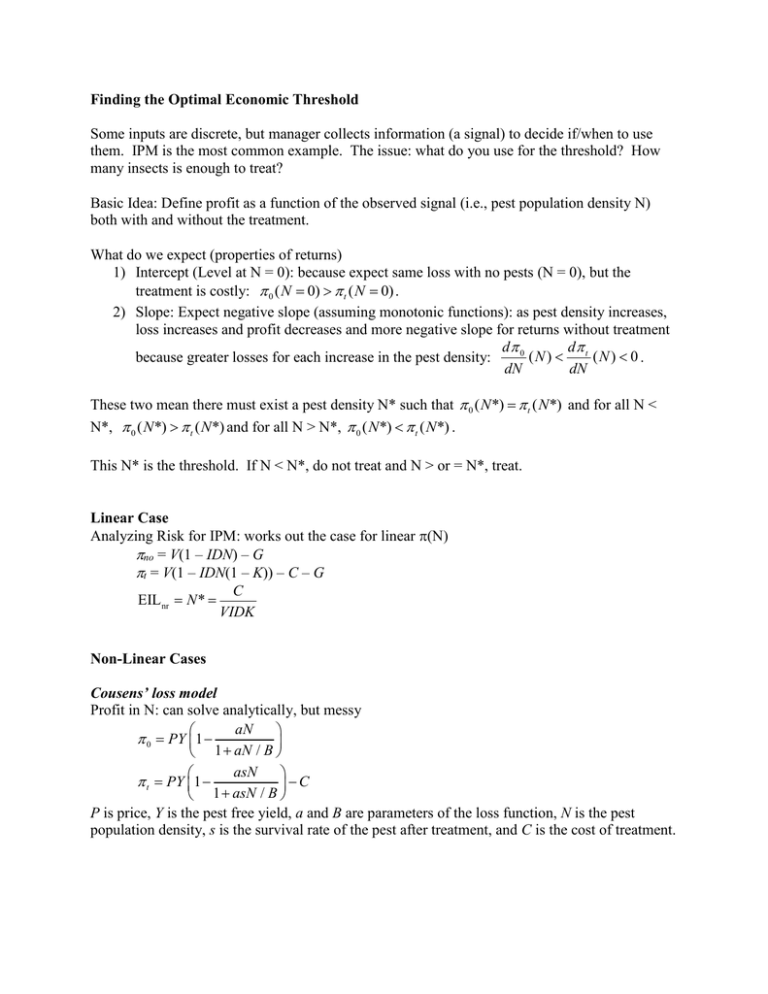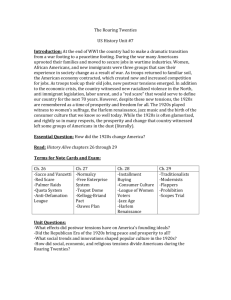Optimal Threshold Notes
advertisement

Finding the Optimal Economic Threshold Some inputs are discrete, but manager collects information (a signal) to decide if/when to use them. IPM is the most common example. The issue: what do you use for the threshold? How many insects is enough to treat? Basic Idea: Define profit as a function of the observed signal (i.e., pest population density N) both with and without the treatment. What do we expect (properties of returns) 1) Intercept (Level at N = 0): because expect same loss with no pests (N = 0), but the treatment is costly: 0 ( N 0) t ( N 0) . 2) Slope: Expect negative slope (assuming monotonic functions): as pest density increases, loss increases and profit decreases and more negative slope for returns without treatment d 0 d (N ) t (N ) 0 . because greater losses for each increase in the pest density: dN dN These two mean there must exist a pest density N* such that 0 ( N *) t ( N *) and for all N < N*, 0 ( N *) t ( N *) and for all N > N*, 0 ( N *) t ( N *) . This N* is the threshold. If N < N*, do not treat and N > or = N*, treat. Linear Case Analyzing Risk for IPM: works out the case for linear (N) no = V(1 – IDN) – G t = V(1 – IDN(1 – K)) – C – G C EIL nr N * VIDK Non-Linear Cases Cousens’ loss model Profit in N: can solve analytically, but messy aN 0 PY 1 1 aN / B asN t PY 1 C 1 asN / B P is price, Y is the pest free yield, a and B are parameters of the loss function, N is the pest population density, s is the survival rate of the pest after treatment, and C is the cost of treatment. Equate and solve for N aN asN PY 1 PY 1 C 1 aN / B 1 asN / B aN asN C aN asN C 1 1 1 aN / B 1 asN / B PY 1 aN / B 1 asN / B PY BaN BasN C BaN BasN C B aN B asN PY B aN B asN PY BaN ( B asN ) BasN ( B aN ) C B 2 aN Ba 2 sN 2 B 2 asN Ba 2 sN 2 C ( B aN )( B asN ) PY ( B aN )( B asN ) PY 2 2 2 B aN B asN C B aN (1 s) C ( B aN )( B asN ) PY ( B aN )( B asN ) PY C C B 2 aN (1 s ) ( B aN )( B asN ) ( B 2 BasN BaN a 2 sN 2 ) PY PY C ( B 2 BasN BaN a 2 sN 2 ) B 2 a (1 s ) N 0 PY C 2 C C 2 2 B Ba (1 s ) N B 2 a (1 s ) N a sN 0 PY PY PY Ca 2 s 2 CBa(1 s) C 2 N B 2 a(1 s) N B 0 PY PY PY Solve using quadratic formula: ax 2 bx c 0 , solution x b b2 4ac 2a Empirically, find the lower root is the one we want Graphics, PY = 100, a = 0.01, B = 0.25, s = 0.10, C = 10, N* = 23.691 Exponential Loss Can’t solve analytically, must use numerical solution algorithm 0 PY exp( N ) t PY exp( sN ) C Equate and solve for N PY exp( N ) PY exp( sN ) C exp( N ) exp( sN ) C 0 PY exp( N ) exp( sN ) F ( N | , s , C , P, Y ) 0 Gives Implicit function F(N) = 0. Use solver in Excel Find the value of N that sets the implicit function F(N) equal to 0 Parameters: = -0.2, PY = 100, s = 0.1, C = 30 Solver gives N* = 2.0838 C PY


